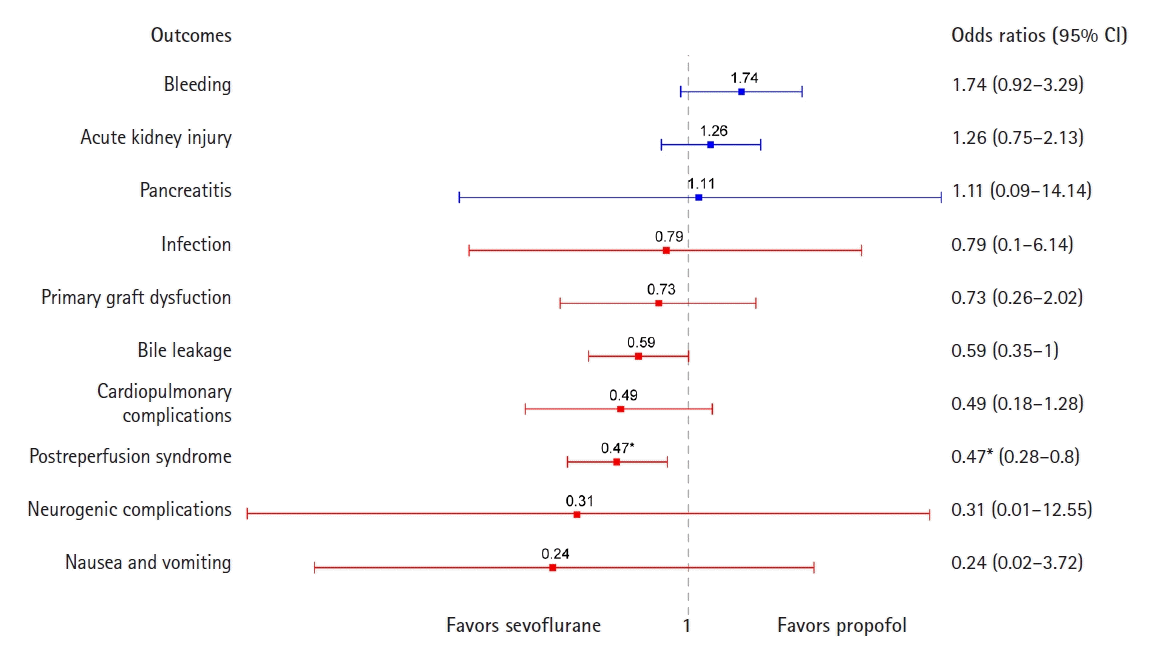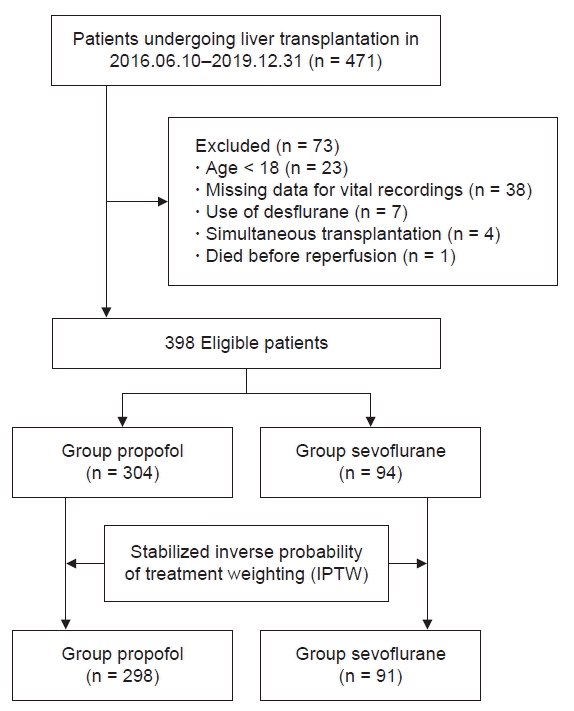1. Manning MW, Kumar PA, Maheshwari K, Arora H. Post-reperfusion syndrome in liver transplantation-an overview. J Cardiothorac Vasc Anesth. 2020; 34:501–11.

2. Siniscalchi A, Gamberini L, Laici C, Bardi T, Ercolani G, Lorenzini L, et al. Post reperfusion syndrome during liver transplantation: from pathophysiology to therapy and preventive strategies. World J Gastroenterol. 2016; 22:1551–69.

3. Chung IS, Kim HY, Shin YH, Ko JS, Gwak MS, Sim WS, et al. Incidence and predictors of post-reperfusion syndrome in living donor liver transplantation. Clin Transplant. 2012; 26:539–43.

4. Paugam-Burtz C, Kavafyan J, Merckx P, Dahmani S, Sommacale D, Ramsay M, et al. Postreperfusion syndrome during liver transplantation for cirrhosis: outcome and predictors. Liver Transpl. 2009; 15:522–9.

5. Iaizzo PA. Handbook of cardiac anatomy, physiology, and devices. Totowa, Humana Press. 2005, p 171-80.
6. Lee J, Yoo YJ, Lee JM, Park YJ, Ryu HG. Sevoflurane versus desflurane on the incidence of postreperfusion syndrome during living donor liver transplantation: a randomized controlled trial. Transplantation. 2016; 100:600–6.
7. Wu ZF, Lin WL, Lee MS, Hung NK, Huang YS, Chen TW, et al. Propofol vs desflurane on the cytokine, matrix metalloproteinase-9, and heme oxygenase-1 response during living donor liver transplantation: a pilot study. Medicine (Baltimore). 2019; 98:e18244.
8. Gajate Martín L, González C, Ruiz Torres I, Fernández Martín C, Martín Grande A, Elías Martín E, et al. Effects of the hypnotic agent on primary graft dysfunction after liver transplantation. Transplant Proc. 2016; 48:3307–11.

9. Mangus RS, Kinsella SB, Farar DT, Fridell JA, Woolf LT, Kubal CA. Impact of volatile anesthetic agents on early clinical outcomes in liver transplantation. Transplant Proc. 2018; 50:1372–7.

10. Smith I, White PF, Nathanson M, Gouldson R. Propofol. An update on its clinical use. Anesthesiology. 1994; 81:1005–43.
11. Hays SR. Inhalation anesthetic agents: clinical effects and uses. Waltham, UptoDate;2020.
12. Lee HC, Jung CW. Vital Recorder-a free research tool for automatic recording of high-resolution time-synchronised physiological data from multiple anaesthesia devices. Sci Rep. 2018; 8:1527.

13. Angeli P, Ginès P, Wong F, Bernardi M, Boyer TD, Gerbes A, et al. Diagnosis and management of acute kidney injury in patients with cirrhosis: revised consensus recommendations of the International Club of Ascites. J Hepatol 2015; 62: 968-74. Erratum in: J Hepatol. 2015; 63:290.

14. Olthoff KM, Kulik L, Samstein B, Kaminski M, Abecassis M, Emond J, et al. Validation of a current definition of early allograft dysfunction in liver transplant recipients and analysis of risk factors. Liver Transpl. 2010; 16:943–9.

15. Schulte PJ, Mascha EJ. Propensity score methods: theory and practice for anesthesia research. Anesth Analg. 2018; 127:1074–84.
16. Lumley T. Analysis of complex survey samples. J Stat Softw. 2004; 9:1–19.

17. Webster NR, Bellamy MC, Lodge JP, Sadek SA. Haemodynamics of liver reperfusion: comparison of two anaesthetic techniques. Br J Anaesth. 1994; 72:418–21.

18. Li H, Weng Y, Yuan S, Liu W, Yu H, Yu W. Effect of sevoflurane and propofol on acute kidney injury in pediatric living donor liver transplantation. Ann Transl Med. 2019; 7:340.

19. Shin S, Joo DJ, Kim MS, Bae MI, Heo E, Lee JS, et al. Propofol intravenous anaesthesia with desflurane compared with desflurane alone on postoperative liver function after living-donor liver transplantation: a randomised controlled trial. Eur J Anaesthesiol. 2019; 36:656–66.
20. Lu CH, Yeh CC, Huang YS, Lee MS, Hsieh CB, Cherng CH, et al. Hemodynamic and biochemical changes in liver transplantation: a retrospective comparison of desflurane and total intravenous anesthesia by target-controlled infusion under auditory evoked potential guide. Acta Anaesthesiol Taiwan. 2014; 52:6–12.

21. Ebert TJ, Muzi M, Berens R, Goff D, Kampine JP. Sympathetic responses to induction of anesthesia in humans with propofol or etomidate. Anesthesiology. 1992; 76:725–33.

22. Robinson BJ, Ebert TJ, O'Brien TJ, Colinco MD, Muzi M. Mechanisms whereby propofol mediates peripheral vasodilation in humans. Sympathoinhibition or direct vascular relaxation? Anesthesiology. 1997; 86:64–72.
23. Kanaya N, Hirata N, Kurosawa S, Nakayama M, Namiki A. Differential effects of propofol and sevoflurane on heart rate variability. Anesthesiology. 2003; 98:34–40.

24. Takizawa D, Sato E, Hiraoka H, Tomioka A, Yamamoto K, Horiuchi R, et al. Changes in apparent systemic clearance of propofol during transplantation of living related donor liver. Br J Anaesth. 2005; 95:643–7.

25. Carles M, Dellamonica J, Roux J, Lena D, Levraut J, Pittet JF, et al. Sevoflurane but not propofol increases interstitial glycolysis metabolites availability during tourniquet-induced ischaemia-reperfusion. Br J Anaesth. 2008; 100:29–35.

26. Novalija E, Kevin LG, Eells JT, Henry MM, Stowe DF. Anesthetic preconditioning improves adenosine triphosphate synthesis and reduces reactive oxygen species formation in mitochondria after ischemia by a redox dependent mechanism. Anesthesiology. 2003; 98:1155–63.

27. Royse CF, Liew DF, Wright CE, Royse AG, Angus JA. Persistent depression of contractility and vasodilation with propofol but not with sevoflurane or desflurane in rabbits. Anesthesiology. 2008; 108:87–93.

28. Mueller AR, Platz KP, Kremer B. Early postoperative complications following liver transplantation. Best Pract Res Clin Gastroenterol. 2004; 18:881–900.

29. Hilmi I, Horton CN, Planinsic RM, Sakai T, Nicolau-Raducu R, Damian D, et al. The impact of postreperfusion syndrome on short-term patient and liver allograft outcome in patients undergoing orthotopic liver transplantation. Liver Transpl. 2008; 14:504–8.

30. Xu S, Ross C, Raebel MA, Shetterly S, Blanchette C, Smith D. Use of stabilized inverse propensity scores as weights to directly estimate relative risk and its confidence intervals. Value Health. 2010; 13:273–7.






 PDF
PDF Citation
Citation Print
Print




 XML Download
XML Download